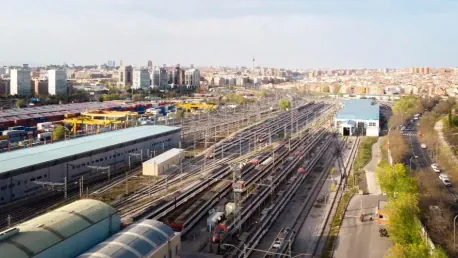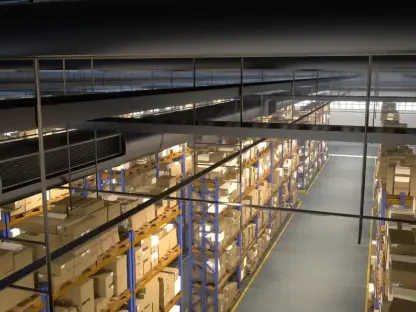Ongoing rail freight disruptions along the Zaragoza-Barcelona axis in northeastern Spain have posed significant challenges for operators due to long-term gauge adaptation works near the Roda de Berà tunnel. This construction effort is an integral part of a larger transition from the Iberian to the standard gauge along the TEN-T Mediterranean Corridor. With a project budget of 16 million euros, the work involves laying a third, mixed-gauge track, aiming to enhance the Zaragoza-Barcelona axis’s international role. Despite the immediate disruptions, this measure is expected to yield long-term improvements in freight efficiency and connectivity.
The Impact of Disruptions
Operational Limitations and Increased Costs
The ongoing construction, projected to last until March 2025, has led to substantial financial and logistical repercussions for rail operators. Spanish infrastructure manager Adif has proposed alternative routes, including the Lleida-Valls line, the Zaragoza-Mora-Reys railway, and a section between Valls and Alcover. However, these alternatives are constrained by shorter train lengths, which range from 450 to 500 meters, significantly reducing capacity. Adding to the complexities, the Valls-Alcover rerouting requires additional maneuvers in Espluga de Francolí, further inflating operational costs.
Juan Diego Pedrero, President of the Spanish Association of Private Railway Companies, has underscored the severe financial and temporal burdens imposed on operators due to these disruptions. The necessity of longer routes, combined with reduced train lengths and extra handling, complicates operations and increases expenses. In some cases, these challenges have led to the cancellation of specific ‘special trains’ that cater to unique shipping requirements. Overall, the disruptions have created a challenging environment for freight companies as they adapt to the new logistical landscape.
Alternative Routes and Their Challenges
Adif’s offered alternatives provide some relief but come with their own set of challenges. The Lleida-Valls line, while a viable alternative, cannot handle the same volume or length of trains as the primary Zaragoza-Barcelona route. Similarly, the Zaragoza-Mora-Reys railway presents limitations that hinder its capacity to serve as a full substitute. The section between Valls and Alcover, another suggested detour, involves additional operational steps, such as maneuvers in Espluga de Francolí, which are both time-consuming and costly. These operational tweaks add layers of complexity and delay to an already strained system.
The necessity to reroute freight traffic not only stretches operational capacities but also increases the frequency of logistical errors and delays. Operators must now navigate an intricate web of routes, which, while maintaining some level of service, fall short of the efficiency and capacity of the original Zaragoza-Barcelona axis. This multifaceted challenge has led to growing frustration among rail operators who are already dealing with reduced margins and heightened competition from other modes of transport, such as road freight.
Long-term Benefits of Gauge Adaptation
Enhancing International Connectivity
The broader effort to standardize rail gauges is driven by the goal of enhancing international rail freight connectivity. The completion of the gauge adaptation work aims to extend the existing standard gauge connection from Barcelona to France further inland to Zaragoza. This will open up new possibilities for seamless cross-border trade and efficient long-distance freight movement. Spain’s initiative mirrors similar global trends, such as Vietnam’s extension of standard gauge rail to China and Sweden’s significant investment in rail freight infrastructure. This strategic shift underscores a global commitment to improving rail freight networks for better international connectivity.
Despite the immediate operational disruptions, the long-term benefits of gauge standardization are evident. A standardized gauge facilitates smoother and more efficient cross-border operations, reduces the need for time-consuming gauge changes, and allows for the integration of various European rail systems. Ultimately, these improvements are expected to boost the competitiveness of the rail freight sector, making it a more viable and attractive option for international trade.
Aligning with Global Trends
Ongoing disruptions in rail freight along the Zaragoza-Barcelona route in northeastern Spain have created significant challenges for operators due to extensive gauge adaptation work near the Roda de Berà tunnel. This construction is a crucial aspect of a broader transition from the Iberian to the standard gauge on the TEN-T Mediterranean Corridor. The project’s budget of 16 million euros is designated for laying an additional mixed-gauge track, which aims to enhance the Zaragoza-Barcelona line’s international connectivity. Though the disruptions are immediate, the long-term benefits of this project are anticipated to significantly improve freight efficiency and overall connectivity for the region. Once completed, the new mixed-gauge track will facilitate smoother international freight movements, as it will align more closely with the standard gauge used across much of Europe, thus minimizing logistical complexities and potentially reducing costs for operators. In the grand scheme, this project holds promise for bolstering the economic dynamism of northeastern Spain through improved transportation infrastructure.









